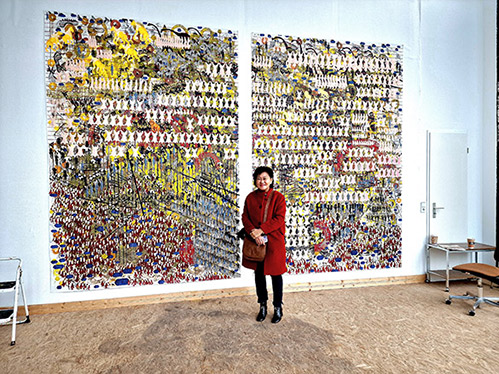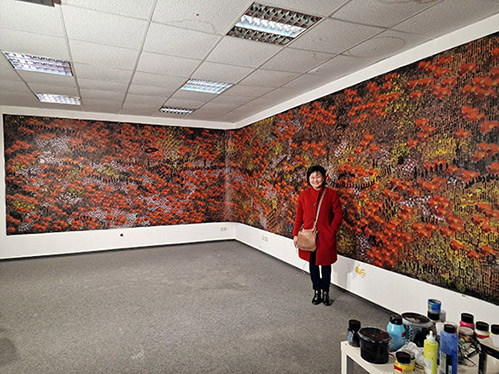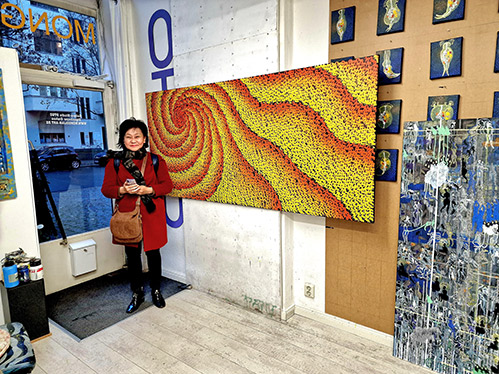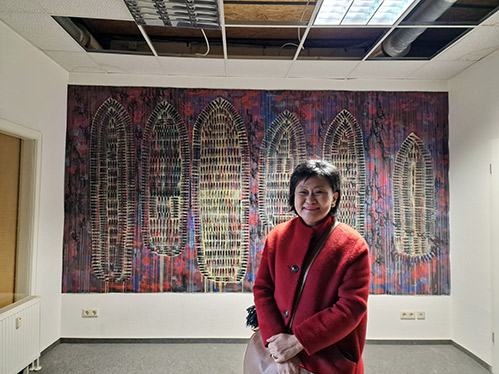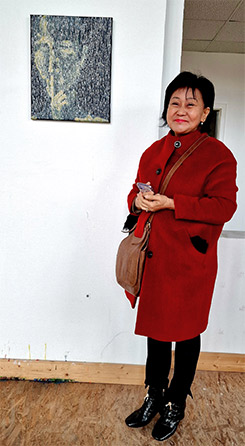
Prof. Dr. Uranchimeg Orna Tsultem. OtGO Studio Berlin
Official Website of Orna Tsultem:
www.artmongolia.org

A Monastery on the Move: Art and Politics in Later Buddhist Mongolia
Uranchimeg Tsultemin
ISBN-13: 9780824878306
Published: December 2020
Additional Information
University of Hawaii Press
304 pages | 164 color and b&w illustrations
- more info: uhpress.hawaii.edu -
In 1639, while the Géluk School of the Fifth Dalai Lama and Qing emperors vied for supreme authority in Inner Asia, Zanabazar (1635–1723), a young descendent of Chinggis Khaan, was proclaimed the new Jebtsundampa ruler of the Khalkha Mongols. Over the next three centuries, the ger (yurt) erected to commemorate this event would become the mobile monastery Ikh Khüree, the political seat of the Jebtsundampas and a major center of Mongolian Buddhism. When the monastery and its surrounding structures were destroyed in the 1930s, they were rebuilt and renamed Ulaanbaatar, the modern-day capital of Mongolia.
Based on little-known works of Mongolian Buddhist art and architecture, A Monastery on the Move presents the intricate and colorful history of Ikh Khüree and of Zanabazar, himself an eminent artist. Author Uranchimeg Tsultemin makes the case for a multifaceted understanding of Mongol agency during the Géluk’s political ascendancy and the Qing appropriation of the Mongol concept of dual rulership (shashin tör) as the nominal “Buddhist Government.” In rich conversation with heretofore unpublished textual, archeological, and archival sources (including ritualized oral histories), Uranchimeg argues that the Qing emperors’ “Buddhist Government” was distinctly different from the Mongol vision of sovereignty, which held Zanabazar and his succeeding Jebtsundampa reincarnates to be Mongolia’s rightful rulers. This vision culminated in their independence from the Qing and the establishment of the Jebtsundampa’s theocractic government in 1911.
A groundbreaking work, A Monastery on the Move provides a fascinating, in-depth analysis and interpretation of Mongolian Buddhist art and its role in shaping borders and shifting powers in Inner Asia.
Author: Uranchimeg Tsultemin
Uranchimeg Tsultemin is Edgar and Dorothy Fehnel Chair of International Studies at the Herron School of Art and Design, Indiana University-Purdue University-Indianapolis (IUPUI).
Reviews and endorsements:
The brilliance of Uranchimeg Tsultemin’s book lies in the recovery of material that has been overlooked—especially art, architecture, and ritual objects—and, moving beyond iconographic and stylistic analyses, to consider their sociopolitical history. Uranchimeg’s use of a wide variety of written and material sources read together and against one another has produced a fascinating study.
—Gray Tuttle, Columbia University
A Monastery on the Move is an impressive and pioneering work. Uranchimeg Tsultemin, one of only a small handful of scholars of Mongolian Buddhist art that I am aware of, weaves history, religion, politics, and Buddhist art into a narrative that illuminates the interactions and mutual influences of these areas in Mongolian religious and political lives. She opens up the world of Mongolian Buddhist art in ways we have not seen before.
—Vesna Wallace, University of California, Santa Barbara
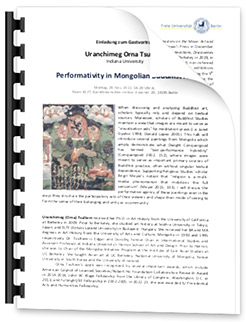
FLYER_Gastvortrag_Orna-Tsultem_20221128_FU_Berlin.pdf
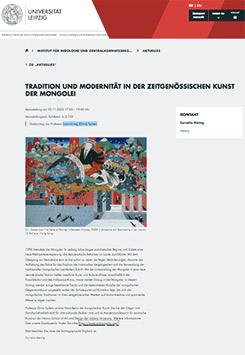
Universität Leipzig:
Tradition und Modernität in der zeitgenössischen Kunst der Mongolei
Veranstaltung am 23.11.2022 17:00 – 19:00 Uhr
Veranstaltungsort: Schillerstr. 6, S 102
Gastvortrag von Professor Uranchimeg (Orna) Tsultem
1992 beendete die Mongolei ihr siebzig Jahre langes sozialistisches Regime und bildete eine neue Mehrparteienregierung, die demokratische Reformen im Lande durchführte. Mit dem Übergang zur Demokratie kam es fast sofort zu vielen wichtigen Veränderungen, darunter die Aufhebung des Tabus für das Studium der historischen Vergangenheit und die Verwendung der traditionellen mongolischen (vertikalen) Schrift. Mit der Umwandlung der Mongolei in eine neue demokratische Nation hielten westliche Kunst- und Kultureinflüsse, einschließlich der Populärkultur und des Hollywood-Kinos, immer stärker Einzug in die Mongolei. In diesem Vortrag werden einige bestehende Trends und die bekanntesten Künstler der mongolischen Gegenwartskunst vorgestellt, wobei der Schwerpunkt auf Künstlern liegt, die sich die mongolischen Traditionen in ihren zeitgenössischen Werken auf höchst kreative und spannende Weise zu eigen machen.
Professor Orna Tsultem ist eine Historikerin der mongolischen Kunst. Sie hat den Edgar- und Dorothy-Fehnel-Lehrstuhl für internationale Studien inne und ist Assistenzprofessorin für asiatische Kunst an der Herron School of Art and Design der Indiana University. Weitere Informationen über unsere Gastdozentin finden Sie unter www.artmongolia.org.
Bitte beachten Sie, dass die Vortragssprache Englisch ist.
Cornelia Meinig
Universität Leipzig
Quelle: www.gkr.uni-leipzig.de
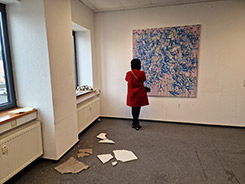
Prof. Dr. Uranchimeg Orna Tsultem. OtGO Studio Berlin
Photo by OtGO 2022
